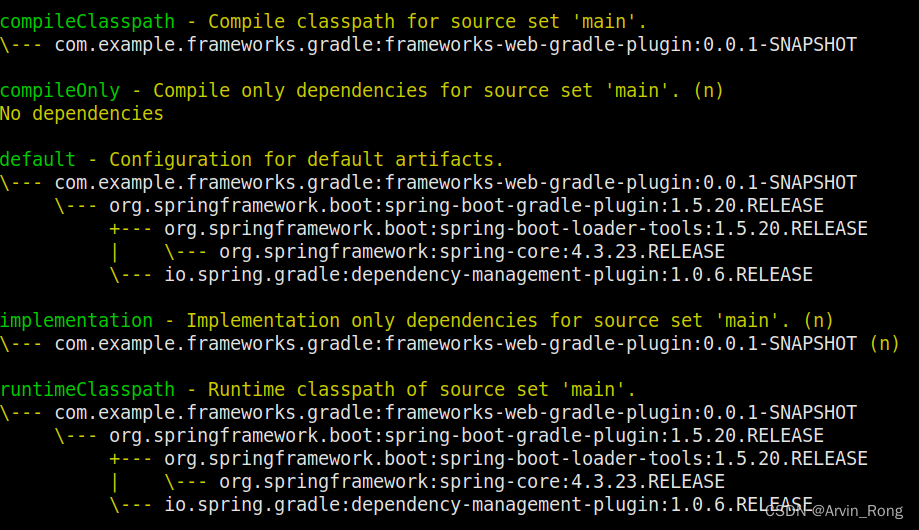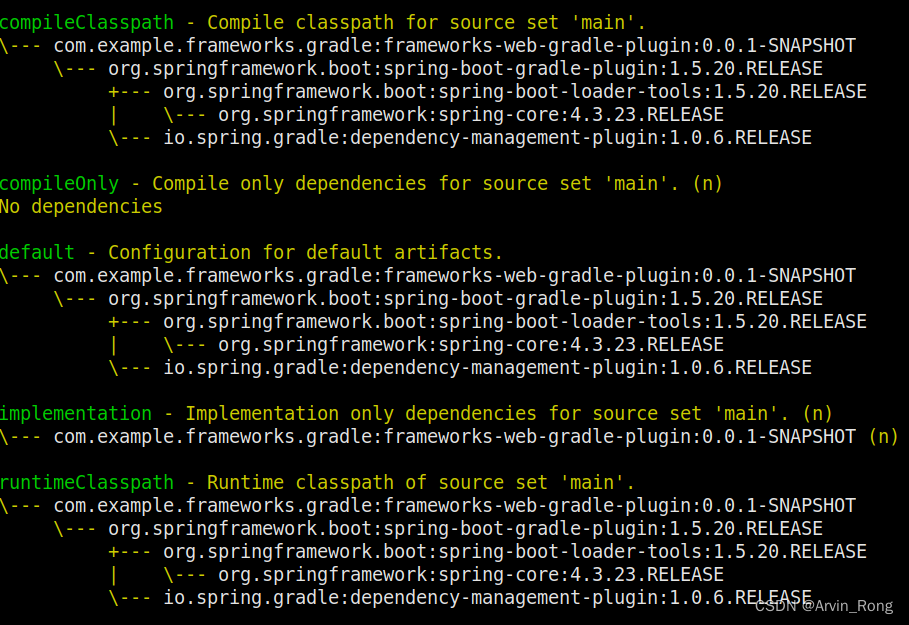Gradle中 Implementation 与API 声明依赖方式的对比
发布时间:2023年12月21日
在Gradle中,implementation和api是声明依赖的两种方式,它们在如何暴露依赖关系方面有所不同:
-
Implementation: 当一个模块使用
implementation声明依赖时,该依赖仅对声明它的模块可见。这意味着该依赖对于该模块的消费者是隐藏的。因此,使用implementation可以提高构建速度,因为更改依赖项不会强制消费者重新编译。 -
API: 相反,当使用
api声明依赖时,这个依赖同时被暴露给该模块的消费者。如果一个模块的公共API在其接口中暴露了第三方库的类或接口,那么这个依赖应该使用api声明。这样做的缺点是,更改api依赖将导致依赖于该模块的所有消费者都需要重新编译。
选择使用implementation还是api取决于你是否想将依赖项暴露给其他依赖于你的模块的模块。
我为测试创建了两个项目:
- 项目A?是一个名为“frameworks-web-gradle-plugin”的Java库项目,依赖于“org.springframework.boot:spring-boot-gradle-plugin:1.5.20.RELEASE”。
- 项目B?通过“implementation 'com.example.frameworks.gradle:frameworks-web-gradle-plugin:0.0.1-SNAPSHOT'”依赖于项目A。
上述依赖关系层次结构看起来像这样:[project-b] -> [project-a] -> [spring-boot-gradle-plugin]
然后我测试了以下场景:
- 使项目A通过implementation依赖于“org.springframework.boot:spring-boot-gradle-plugin:1.5.20.RELEASE”。
在项目B根目录中使用终端运行gradle dependencies命令,通过输出的截图我们可以看到“spring-boot-gradle-plugin”出现在runtimeClasspath依赖树中,但不在compileClasspath中。我认为这正是我们不能在B中使用由A中implementation方式声明的依赖spring-boot-gradle-plugin的原因,因为compileClasspath中没有spring-boot-gradle-plugin,代码不会通过编译。
- 这次修改为使项目A通过api依赖于“org.springframework.boot:spring-boot-gradle-plugin:1.5.20.RELEASE”。
再次在项目B根目录中的终端运行gradle dependencies命令。现在“spring-boot-gradle-plugin”同时出现在compileClasspath和runtimeClasspath依赖树中。
可以看到的一个显著差异,在生产者/库项目中用implementation方式声明的依赖不会出现在消费者项目的compileClasspath中,因此我们不能在消费者项目中使用相应的库。
更多参考: StackOverflow: Gradle Implementation vs API configuration
文章来源:https://blog.csdn.net/arvinrong/article/details/135134127
本文来自互联网用户投稿,该文观点仅代表作者本人,不代表本站立场。本站仅提供信息存储空间服务,不拥有所有权,不承担相关法律责任。 如若内容造成侵权/违法违规/事实不符,请联系我的编程经验分享网邮箱:chenni525@qq.com进行投诉反馈,一经查实,立即删除!
本文来自互联网用户投稿,该文观点仅代表作者本人,不代表本站立场。本站仅提供信息存储空间服务,不拥有所有权,不承担相关法律责任。 如若内容造成侵权/违法违规/事实不符,请联系我的编程经验分享网邮箱:chenni525@qq.com进行投诉反馈,一经查实,立即删除!
最新文章
- Python教程
- 深入理解 MySQL 中的 HAVING 关键字和聚合函数
- Qt之QChar编码(1)
- MyBatis入门基础篇
- 用Python脚本实现FFmpeg批量转换
- uni-app 经验分享,从入门到离职(实战篇)——模拟从后台获取图片路径数据后授权相册以及保存图片到本地(手机相册)
- Java泛型-13
- 类和对象(下篇)
- 生物制药厂污水处理需要哪些工艺设备
- 工程项目管理软件哪个好用?这款顶级软件别错过!
- 深入探索服装网商品详情API:实时数据获取、安全与隐私保护及商业价值实践
- 一套高效使用的 Vue3 + Springboot 前端低代码框架
- 软件测评中心▏正式验收测试和非正式验收的优缺点简析
- java合并两张图片
- SpringMVC SpringMVC概述